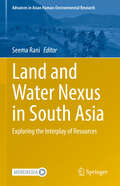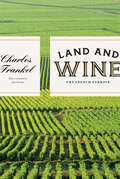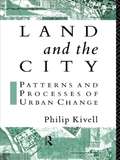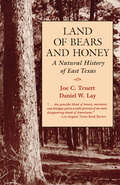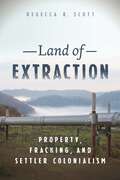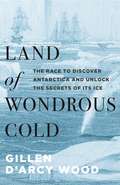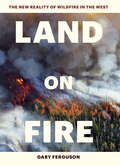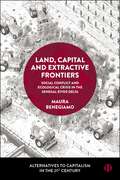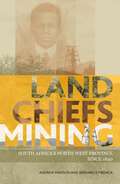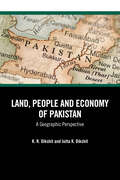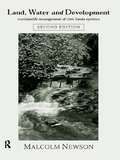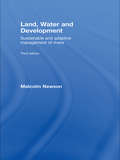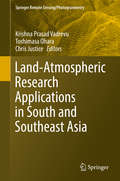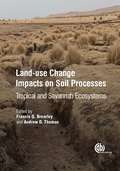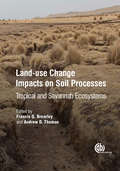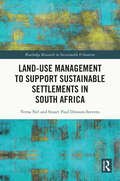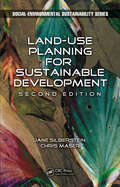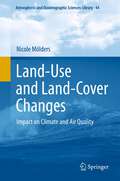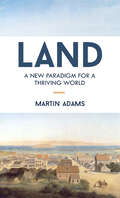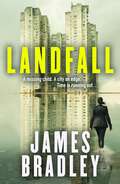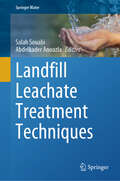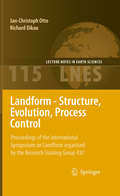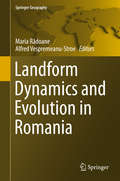- Table View
- List View
Land and Water Nexus in South Asia: Exploring the Interplay of Resources (Advances in Asian Human-Environmental Research)
by Seema RaniThis book aims to unravel the intricate relationship between land and water resources and delve into their interdependencies, synergies, and challenges. As the world grapples with pressing issues such as water scarcity, land degradation, and climate change, understanding the complex dynamics and interplay between these two critical resources has become more crucial than ever. This comprehensive volume brings together multidisciplinary perspectives from leading experts in the field, offering an integrated approach to studying the land-water nexus. The book provides readers with a clear understanding of how land and water interact and delves into key topics such as land use change and its impacts on water resources, water management in agricultural landscapes, land-water interactions in aquatic ecosystems, urbanization and water resource management, and climate change's influence on the land-water nexus. Moreover, the book investigates integrated governance frameworks, policy considerations, and sustainable development approaches that are essential for effective land and water resource management. It also sheds light on future perspectives and research frontiers, envisioning innovative solutions to address emerging challenges in this field. By synthesizing current knowledge, showcasing case studies, and presenting cutting-edge research, this book provides a valuable resource for researchers, policymakers, and professionals working in water resource management, environmental science, agriculture, urban planning, and sustainable development. The book's holistic approach encourages readers to envision sustainable pathways that balance the needs of both land and water, fostering a resilient and harmonious future for our planet.
Land and Water Student Activity Book
by The Editors at the The National Science Resources CenterThe book talks about land, water, their importance, and ways of preserving these natural resources along with related activities for students.
Land and Wine: The French Terroir
by Charles FrankelThis in-depth tour of the French winemaking regions illustrates how the soil, underlying bedrock, and microclimate shape the personality of a wine.France has long been the world’s greatest wine-producing country. Its various regions each offer unique tasting experiences, from the spice of Bordeaux to the berry notes of the Loire Valley. In Land and Wine, geologist Charles Frankel guides readers through these and ten other regions, including Alsace, Burgundy, Champagne, Provence, and the Rhône valley, to explore the full meaning of terroir.Frankel describes how Cabernet Franc takes on a completely different character depending on whether it is grown on gravel or limestone; how Sauvignon yields three different products in the hills of Sancerre; how Pinot Noir will give radically different wines on a single hill in Burgundy as the vines progress upslope; and how the soil of each château in Bordeaux has a say in the blend ratios of Merlot and Cabernet-Sauvignon.Land and Wine provides a detailed understanding of the variety of French wine as well as a look at the geological history of France, complete with volcanic eruptions, dinosaurs, and a menagerie of fossils flavoring the vineyards. Frankel also blends in anecdotes about winemakers and historic wine enthusiasts while offering travel tips and itineraries for visiting the wineries today.
Land and the City: Patterns and Processes of Urban Change (Geography And Environment Ser.)
by Philip KivellFirst Published in 2004. Routledge is an imprint of Taylor & Francis, an informa company.
Land of Bears and Honey: A Natural History of East Texas
by Joe C. Truett Daniel W. LayThis award-winning &“gem&” of a conservation classic tells the story of the land, wildlife, and ecology of East Texas (Quarterly Review of Biology).Winner of the Ottis Lock Endowment Award from the East Texas Historical Association; the Texas Literary Festival Award for Nonfiction from the Southwestern Booksellers Association & Dallas Times Herald; and the Annual Publication Award, Texas Chapter of the Wildlife Society As hickory groves and fox squirrels began to vanish from the East Texas landscape in the second half of the twentieth century, two biologists who specialized in wildlife and endangered species began work on Land of Bears and Honey. Their purpose was not only to eulogize what was lost, but to encourage us to save what we still can. The result is an &“elegant chronicle of the natural history of a once-rich area [that] will appeal strongly to birders, ecologists, to anyone who enjoys the outdoors&” (Publishers Weekly). &“This deceptively slender volume is three things: a how-to-book, an aesthetic feast and a moral tale.&” —Dallas Morning News &“To compare the style and content of this little book to that of the late Aldo Leopold is indeed high praise, yet the reviewer finds this comparison valid.&” —Quarterly Review of Biology &“In Land of Bears and Honey, East Texans have their own regional Walden, written with keen historical perspectives, literary style, and deep respect for the land.&” —East Texas Historical Journal &“This graceful blend of history, narrative and dialogue paints a noble portrait of one more disappearing chunk of Americana.&” —Los Angeles Times Book Review
Land of Bears and Honey: A Natural History of East Texas
by Joe C. Truett Daniel W. LayThis award-winning &“gem&” of a conservation classic tells the story of the land, wildlife, and ecology of East Texas (Quarterly Review of Biology).Winner of the Ottis Lock Endowment Award from the East Texas Historical Association; the Texas Literary Festival Award for Nonfiction from the Southwestern Booksellers Association & Dallas Times Herald; and the Annual Publication Award, Texas Chapter of the Wildlife Society As hickory groves and fox squirrels began to vanish from the East Texas landscape in the second half of the twentieth century, two biologists who specialized in wildlife and endangered species began work on Land of Bears and Honey. Their purpose was not only to eulogize what was lost, but to encourage us to save what we still can. The result is an &“elegant chronicle of the natural history of a once-rich area [that] will appeal strongly to birders, ecologists, to anyone who enjoys the outdoors&” (Publishers Weekly). &“This deceptively slender volume is three things: a how-to-book, an aesthetic feast and a moral tale.&” —Dallas Morning News &“To compare the style and content of this little book to that of the late Aldo Leopold is indeed high praise, yet the reviewer finds this comparison valid.&” —Quarterly Review of Biology &“In Land of Bears and Honey, East Texans have their own regional Walden, written with keen historical perspectives, literary style, and deep respect for the land.&” —East Texas Historical Journal &“This graceful blend of history, narrative and dialogue paints a noble portrait of one more disappearing chunk of Americana.&” —Los Angeles Times Book Review
Land of Extraction: Property, Fracking, and Settler Colonialism
by Rebecca R. Scott2024 Outstanding Academic Title, given by Choice ReviewsExplores fracking’s dual impact on settler colonial culture and sustainabilityThrough meticulous research and poignant storytelling, Land of Extraction unravels the complex web of relationships between humans, places, and the environment, all bound by the concept of private property. It presents a thought-provoking analysis of how settler colonial culture imposes limits on environmental politics.Drawing on real-life events, fictional portrayals of fossil-fuel driven apocalypses, and firsthand ethnographic accounts of the fracking and pipeline boom in West Virginia, Rebecca R. Scott argues that the American dream’s promise of empowerment through property ownership actually restricts action against extractive industries and hampers the progress of environmental justice coalitions.As the ever-expanding reach of natural gas and pipeline industries takes its toll on communities, the book reveals the fractures in landowners’ reliance on private property, opening the door to more sustainable futures. A powerful call to reevaluate our perspectives and challenge the status quo, this book will leave readers questioning the foundations of our society and the possibilities that lie ahead.
Land of Wondrous Cold: The Race to Discover Antarctica and Unlock the Secrets of Its Ice
by Gillen D’Arcy WoodA gripping history of the polar continent, from the great discoveries of the nineteenth century to modern scientific breakthroughsAntarctica, the ice kingdom hosting the South Pole, looms large in the human imagination. The secrets of this vast frozen desert have long tempted explorers, but its brutal climate and glacial shores notoriously resist human intrusion. Land of Wondrous Cold tells a gripping story of the pioneering nineteenth-century voyages, when British, French, and American commanders raced to penetrate Antarctica’s glacial rim for unknown lands beyond. These intrepid Victorian explorers—James Ross, Dumont D’Urville, and Charles Wilkes—laid the foundation for our current understanding of Terra Australis Incognita.Today, the white continent poses new challenges, as scientists race to uncover Earth’s climate history, which is recorded in the south polar ice and ocean floor, and to monitor the increasing instability of the Antarctic ice cap, which threatens to inundate coastal cities worldwide. Interweaving the breakthrough research of the modern Ocean Drilling Program with the dramatic discovery tales of their Victorian forerunners, Gillen D’Arcy Wood describes Antarctica’s role in a planetary drama of plate tectonics, climate change, and species evolution stretching back more than thirty million years. An original, multifaceted portrait of the polar continent emerges, illuminating our profound connection to Antarctica in its past, present, and future incarnations.A deep-time history of monumental scale, Land of Wondrous Cold brings the remotest of worlds within close reach—an Antarctica vital to both planetary history and human fortunes.
Land on Fire: The New Reality of Wildfire in the West
by Gary FergusonWildfire season is burning longer and hotter, affecting more and more people, especially in the west. Land on Fire explores the fascinating science behind this phenomenon and the ongoing research to find a solution. This gripping narrative details how years of fire suppression and chronic drought have combined to make the situation so dire. Award-winning nature writer Gary Ferguson brings to life the extraordinary efforts of those responsible for fighting wildfires, and deftly explains how nature reacts in the aftermath of flames. Dramatic photographs reveal the terror and beauty of fire, as well as the staggering effect it has on the landscape.
Land, Capital and Extractive Frontiers: Social Conflict and Ecological Crisis in the Senegal River Delta (Alternatives to Capitalism in the 21st Century)
by Maura BenegiamoThis book examines ‘land-grabbing’ - its colonial roots and the fraught relationship between capital and nature amidst the current global socio-ecological crisis. Through ethnographic and archival research, Maura Benegiamo investigates an Italian company’s acquisition of 20,000 hectares in Senegal’s River Delta for agrofuel production and delves into the struggles of pastoral communities affected by the project. Through this landmark case, the book shows how European energy and global food security policies are reshaping rural spaces, expanding agrarian extractivism in sub-Saharan Africa. By shedding light on how contemporary capital–nature relationships perpetuate socio-ecological crises and colonial models, the book highlights the enduring forms of opposition to these processes. At the heart of these struggles lies a crucial question: how can we understand today’s crises while reclaiming alternative ways of living, producing and inhabiting the land?
Land, Chiefs, Mining: South Africa's North West Province since 1840
by Andrew Manson Bernard MbengaLand, Chiefs, Mining explores aspects of the experience of the Batswana in the thornveld and bushveld regions of the North-West Province, shedding light on defi ning issues, moments and individuals in this lesser known region of South Africa. Some of the focuses are: an important Tswana kgosi (chief ), Moiloa II of the Bahurutshe; responses to and participation in the South African War and its aftermath, 1899-1907; land acquisition; economic and political conditions in the reserves; resistance to Mangope’s Bophuthatswana; the impact of game parks and the Sun City resort; rural resistance and the liberation struggle; and African reaction to the platinum mining revolution. Written in a direct and accessible style, and illustrated with photographs and maps, the book provides an understanding, for a general reader ship, of the region and its recent history. At the same time it opens up avenues for further research. The authors, Andrew Manson and Bernard Mbenga, both based at North-West University, Mahikeng Campus, have, for some thirty years, been studying and writing on the region’s past.
Land, People and Economy of Pakistan: A Geographic Perspective
by K. R. Dikshit Jutta K. DikshitThe book unravels the complexity of Pakistan’s physical terrain, from the Arabian Sea coast to the Himalayan heights, focusing on its bio-climatic environment. While throwing light on the evolution of societal organisation and the nature and intensity of economic enterprises, it discusses the human response to the natural milieu and the way natural resources have been harnessed.This volume discusses the distribution of natural resources and deciphers the evolutionary development of manufacturing, transport and trade, the main non-agricultural enterprises, and looks at the potential for their growth. It provides an overview of the country`s economy and its fluctuations through different political regimes. It also investigates the country’s diverse social, linguistic, and ethnic composition. A habitat study, incorporating villages and towns and their numerical and spatial distribution and also the hierarchical organisation of rural society have received a special focus in the book.The book, with its qualitative and quantitative information, will be useful to students, teachers and researchers studying physical geology, climatology, hydrology, soil science, environmental studies, archaeology, sociology, economics, demography, area studies and regional development studies. It will also be an indispensable companion to professionals in floral-landscaping, habitat study, administrators, and policymakers.
Land, Water and Development: Sustainable Management of River Basin Systems
by Malcolm NewsonThis is a fully revised and expanded second edition of Malcolm Newson's acclaimed book. Exploring in greater depth the meaning of sustainability in river basin development this new edition:* highlights the rapid evolution of practical concepts since the Rio Earth Summit* features new illustrations and case studies from Australia, South Africa and Israel* makes the ecosystem model more explicit throughout* strengthens coverage of the linkages between land and water management.
Land, Water and Development: Sustainable and Adaptive Management of Rivers
by Malcolm NewsonWater is newsworthy: there is, or will be, a world water crisis. Aggravated by climate change, we are approaching the limits of human exploitation of freshwater resources, notably in growing essential food. The complexities and uncertainties associated with improving our management of fresh water take the potential remedies out of the hands of simple, local, hard engineering and into much larger units – the basin, the ecosystem and the global context, and also require longer term perspectives. The Third Edition follows the same structure as its predecessors, presenting the historical and scientific backgrounds to land-water interactions and establishing the links with development processes and policies. Throughout, its two major messages are that our new philosophy should be one of ‘humans in the ecosystem’ and that the guidance from science, being uncertain and contested, must be operationalized in a participatory system of governance based on participation. Following a review of progress towards these elements in the developed world, the international case studies update the situation in the developing world following the Millennium Development Goals, our new emphasis on poverty and on global food supplies. This book covers the multitude of scientific research findings, development of ‘tools’ and spatial/temporal scale challenges which have emerged in the last decade. Tensions are highlighted in the current and future role of large dams, country studies are retained (and considerably updated) and development contexts are explored in greater depth as a dividing line in capacity to cope with land and water stress. "Technical issues" have been expanded to cover major droughts, environmental flows and the restoration of rivers and wetlands. A separate chapter picks up these themes under terms of their relationship with uncertainty and the widespread perception that a new ethos of adaptive management is needed in the water sector. For students of geography, environmental science, hydrology, and development studies this innovative edition provides a reasoned, academic basis of evidence for sustainable, adaptive management of rivers and related large-scale ecosystems using more than 600 new sources. It will also prove invaluable for lecturers and practitioners.
Land-Atmospheric Research Applications in South and Southeast Asia (Springer Remote Sensing/photogrammetry Ser.)
by Krishna Prasad Vadrevu Toshimasa Ohara Chris JusticeThis edited volume sheds new light on the impact of rapid Land Use/Cover Changes (LU/CC) on greenhouse gases (GHG’s) and aerosol emissions in South and Southeast Asia. Several countries in South/Southeast Asia have the highest population growth rates in the world, which is the main cause for LU/CC. Conversion of dense forests to agricultural areas and then to residential and urban areas is most commonly observed in South/Southeast Asian countries with a significant release of GHG’s and aerosols. The book showcases several case studies on the use of remote sensing and geospatial technologies to quantify biomass burning and air pollution impacts, aerosol pollution, LU/CC, and impacts on ecosystem services. The book also includes articles on regional initiatives in research, capacity building, and training. The authors of this book are international experts in the field, and their contributions highlight significant drivers and impacts of air pollution in South/Southeast Asia. Readers will discover the latest tools and techniques, in particular, the use of satellite remote sensing and geospatial technologies for quantifying GHG’s, aerosols and pollution episodes in this region.
Land-Use Change Impacts on Soil Processes
by Andrew Thomas Subrata Ghoshal Chaudhuri Heather D’angelo Raghavan Dinesh Francis Brearley Caitlyn Gillikin Arkalgud Ganeshamurthy Krista Mcguire Dina MerrerThis book examines the effects that land-use changes (notably agricultural intensification, logging, soil erosion, urbanisation and mining) have on soil characteristics and processes in tropical and savannah environments. It covers a range of geographical regions and environments as impacts of land use change are often site specific. The effects of land use change on various aspects of the soil ecosystem from both a chemical and biological perspective will be examined.
Land-Use Change Impacts on Soil Processes: Tropical and Savannah Ecosystems
by Subrata Ghoshal Chaudhuri Raghavan Dinesh Caitlyn Gillikin Arkalgud Ganeshamurthy Dina Merrer Heather D’Angelo Krista McGuireThis book examines the effects that land-use changes (notably agricultural intensification, logging, soil erosion, urbanisation and mining) have on soil characteristics and processes in tropical and savannah environments. It covers a range of geographical regions and environments as impacts of land use change are often site specific. The effects of land use change on various aspects of the soil ecosystem from both a chemical and biological perspective will be examined.
Land-Use Management to Support Sustainable Settlements in South Africa (Routledge Research in Sustainable Urbanism)
by Verna Nel Stuart Denoon-StevensThis book provides a theoretical and practical foundation needed to change the practice of land use management in Southern Africa. It presents an overview of alternative land use management system for South African municipalities that is economically, socially and environmentally more sustainable than many of the land use schemes in effect at present. Land use management is a component of spatial governance that controls the nature and extent of development to prevent harmful impacts on people and the environment. As the current system with its colonial/modernist planning and regulatory mechanisms were never designed to deal with rapid change, urbanisation and informality, a different form of land development and land use management is necessary. This timely book reflects the culmination of many years of practical experience and research into various aspects of land use management by the authors and studies undertaken by their master’s and doctoral students. The book goes beyond an analysis of the problems and suggests concrete proposals that can be applied throughout Southern Africa based on a rural to urban transect. This book is directed to a broad range of readers interested in spatial planning and land use management. It will be of interest to those in the fields of geography, urban studies, urban design, planning and architecture.
Land-Use Planning for Sustainable Development (Social Environmental Sustainability)
by Chris Maser Jane Silberstein M.A.Thirteen years ago, the first edition of Land-Use Planning for Sustainable Development examined the question: is the environmental doomsday scenario inevitable? It then presented the underlying concepts of sustainable land-use planning and an array of alternatives for modifying conventional planning for and regulation of the development of land. Th
Land-Use and Land-Cover Changes
by Nicole MöldersWildfires, changing glaciers, deforestation, open-pit mining, increasing demands for food and bio-fuel production and the growth of megacities change our landscape. The book comprehensively reviews the current knowledge on how natural and anthropogenic land-use/cover changes affect weather, air quality and climate worldwide and explains how these changes may trigger further land-use/cover changes. It discusses how anthropogenic land-use/cover changes have affected local and regional climate and air quality since the settlement of America and the industrialisation. It addresses the topic how long-range transport of pollutants and dust of devasted areas as well as teleconnections may cause changes far away from the areas where the land-use/cover changes occurred, for which land-use/cover change may become an international issue similar to CO2. It also discusses relations to global change and future societal and scientific challenges related to land-use/cover changes.
Land: A New Paradigm for a Thriving World
by Martin AdamsWhat if we lived in a world where everyone had enough? A world where everyone mattered and where people lived in harmony with nature? What if the solution to our economic, social, and ecological problems was right underneath our feet? Land has been sought after throughout human history. Even today, people struggle to get onto the property ladder and view real estate as an important way to build wealth. Yet, as the reader will discover through this book, the act of owning land—and our urge to profit from it—causes economic booms and busts, social and cultural decline, and environmental devastation. Land: A New Paradigm for a Thriving World introduces a radically new economic model that ensures a more fair and abundant reality for everyone. It is a book for those who dream of a better world, for themselves and future generations.Table of ContentsIntroduction Part I: The Cost of Ignorance1. The Production of Wealth 2. The Value of Location3. The Free Market4. Social Decline5. Business Recessions6. Ecocide7. Earth, Our HomePart II: A New Paradigm for a Thriving World8. Restoring Communities9. Keep What You Earn, Pay for What You Use10. Local Autonomy11. Affordable Housing12. Thriving Cities13. Sustainable Farming14. The Price of Peace15. A New ParadigmEpilogue: A Personal NoteAppendix: The Math Behind the ScienceReferences & Suggestions for Further ReadingEndnotesIndex
Landfall
by James BradleyA gripping near-future thriller exploring the detrimental effects of climate change on ordinary lives.
Landfill Leachate Treatment Techniques (Springer Water)
by Salah Souabi Abdelkader AnouzlaThis book is a ready reckoner of recent information regarding the impact of leachate landfills, leachate treatment, and heavy metals on a single platform. The amount of waste is constantly growing due to population growth and the evolution of socioeconomic activities. Burying this waste produces leachate, a contaminated effluent created during the decomposition of organic waste and containing harmful substances like heavy metals, polyphenols, volatile organic compounds, and microorganisms. These effluents emit unpleasant odors associated with ammonium ions. These discharges significantly impact the environment. As a result, the master's and doctoral academics, researchers, and students will be able to comprehend the most recent developments in municipal solid waste landfill operations, supporting their research. This book inspires readers on how to deal with environmental pollution problems due to leachate contamination in freshwater and agricultural soils using a variety of technologies.
Landform - Structure, Evolution, Process Control
by Richard Dikau Jan-Christoph OttoThe book will offer a broad interdisciplinary overview of state of the art research on landform related issues. This includes contributions from Physical Geography (incl. Geomorphology, Ecology, Remote Sensing, Hydrology, and Climatology), Meteorology, Geoinformatics, Cartography, and Computer Science. The book combines introductory/overview papers as well as case studies. The case studies present various new approaches towards a better understanding of the role of landform as a boundary surface between the different earth spheres. Additionally, new methods of handling, modelling and visualisation of digital landform data (incl. digital elevation models, weather forecasting models, hydrological modelling, and ecological modelling) are introduced.
Landform Dynamics and Evolution in Romania
by Maria Radoane Alfred Vespremeanu-StroeNew and innovative scientific theories, discussion and explanations are presented on landform dynamics and evolution in Romania along with a comprehensive understanding of the geomorphological processes shaping the large variety of Romania's landscape. Thematically arranged the book deals with landform dynamics of specific relief types: glacial and periglacial, denudational, fluvio-denudational, fluvial, karst and coasts, as well as sediment fluxes, geomorphic hazards and risks. The authors are key scientists and researchers in the field and offer innovative views on research methods and concepts applied to the topics in question. This work will be of interest to students and researchers in geography, geomorphology, geology, environmental science, paleoclimatology and soil science as well as policy and decision-makers in spatial planning.
